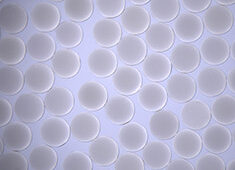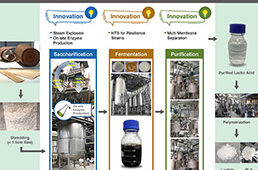A research team at Northwestern University has synthesized, characterized, and computationally simulated/validated the behavior of two new metal–organic framework (MOF) materials displaying the highest experimental Brunauer–Emmett–Teller (BET) surface areas of any porous materials reported to date (7000 m2/g). Image: Northwestern University |
Northwestern
University researchers have broken a world record by creating two new
synthetic materials with the greatest amount of surface areas reported
to date. Named NU-109 and NU-110, the materials belong to a class of
crystalline nanostructure known as metal-organic frameworks (MOFs) that
are promising vessels for natural gas storage for vehicles, catalysts,
and other sustainable materials chemistry.
The
materials’ promise lies in their vast internal surface area. If the
internal surface area of one NU-110 crystal the size of a grain of salt
could be unfolded, the surface area would cover a desktop. Put another
way, the internal surface area of one gram of NU-110 would cover
one-and-a-half football fields.
A
paper describing the findings, “Metal-organic Framework Materials with
Ultrahigh Surface Areas: Is the Sky the Limit?” was published August 20
in the Journal of the American Chemical Society.
The
research team, led by Omar Farha, research associate professor of
chemistry in the Weinberg College of Arts and Sciences, has synthesized,
characterized, and computationally simulated the behavior of the two
MOFs that display the highest experimental Brunauer-Emmett-Teller
surface areas of any porous material on record, 7,000 m2/g; that is, one
kilogram of the material contains an internal surface area that could
cover seven square kilometers. (Brunauer-Emmett-Teller, or BET, is an
analysis technique for measuring the surface area of a material.)
The
extremely high surface area, which is normally not accessible due to
solvent molecules that stay trapped within the pores, was achieved using
a carbon dioxide activation technique. As opposed to heating, which can
remove the solvent but also damage the MOF material, the carbon
dioxide-based technique removes the solvent gently and leaves the pores
completely intact.
The
development could rapidly lead to further advances. MOFs are composed
of organic linkers held together by metal atoms, resulting in a
molecular cage-like structure. The researchers believe they may be able
to more than double the surface area of the materials by using less
bulky linker units in the materials’ design.
The
research comes from the labs of Joseph T. Hupp, professor of chemistry
in Weinberg, and Randall Q. Snurr, professor of chemical and biological
engineering at the McCormick School of Engineering.
Other
authors include SonBinh Nguyen, professor of chemistry in Weinberg;
Ibrahim Eryazici, Nak Cheon Jeong, Brad G. Hauser, Amy A. Sarjeant, and
Christopher E. Wilmer, all of Northwestern; and A. Özgür Yazaydin of the
University of Surrey in the United Kingdom.
The
MOF-designing and -synthesizing technology is being commercialized by
NuMat Technologies, a Northwestern startup that has won more than $1
million in business plan competitions since incorporating in February.
Metal-organic Framework Materials with Ultrahigh Surface Areas: Is the Sky the Limit?
Source: Northwestern University





